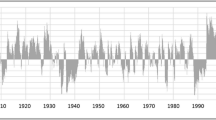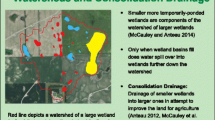Abstract
The response of ecosystems to climate warming is likely to include threshold events when small changes in key environmental drivers produce large changes in an ecosystem. Wetlands of the Prairie Pothole Region (PPR) are especially sensitive to climate variability, yet the possibility that functional changes may occur more rapidly with warming than expected has not been examined or modeled. The productivity and biodiversity of these wetlands are strongly controlled by the speed and completeness of a vegetation cover cycle driven by the wet and dry extremes of climate. Two thresholds involving duration and depth of standing water must be exceeded every few decades or so to complete the cycle and to produce highly functional wetlands. Model experiments at 19 weather stations employing incremental warming scenarios determined that wetland function across most of the PPR would be diminished beyond a climate warming of about 1.5–2.0 °C, a critical temperature threshold range identified in other climate change studies.







Similar content being viewed by others
References
Batzer DP, Sharitz RR (2006) Ecology of freshwater and estuarine wetlands. University of California Press, p. 568
Burkett V et al. (2005) Nonlinear dynamics in ecosystem response to climatic change: case studies and policy implications. Ecological Complexity 2:357–394
Clair TA (1998) Canadian freshwater wetlands and climate change. Clim Chang 40:163–165
Eischeid JK, Pasteris PA, Diaz LH, Plantico MS, Lott NJ (2000) Creating a serially complete, national daily time series of temperature and precipitation for the western United States. J Appl Meteorol 39(9):1580–1591. doi:10.1175/1520-0450(2000)039<1580:CASCND>2.0.CO:2
Fagre DB et al. (2009) Thresholds of climate change in ecosystems. A report by the U. S. Climate Science Program and the Subcommittee on Global Change Research. U.S. Geological Survey, Reston
Gardner RH et al. (1987) Neutral models for the analysis of broad-scale landscape pattern. Landscape Ecology 1:19–28
Giorgi F, Mearns LO (1991) Approaches to regional climate change simulation: Rev. of Geophys. 29:191–216
Groffman PM et al. 2006. Ecological thresholds: the key to successful environmental management or an important concept with no practical application? Ecosystems 9:1–13
Gunderson LH (2000) Ecological resilience–theory to practice. Annu Rev Ecol Syst 31:421–439
Gunderson LH, Holling CS (eds) (2002) Panarchy: understanding transformations in human and natural systems. Island Press, Washington, DC
Guntenspergen GR and Gross J. 2014. Threshold concepts: implications for the management of natural resources. Pp. 1–7, In: Guntenspergen GR (ed). Application of threshold concepts in natural resource decision making. doi:10.1007/978-1-4899-8041-0_1. Springer Science + Business Media Publ.
Hansen J, Kharecha P, Sato M, Masson-Delmonte V, Ackerman F, Beerling DJ, Hearty PJ, Hoegh-Guldberg O, Hsu S-L, Parmesan C, Rockstrom J, Rohling EJ, Sachs J, Smith P, Steffen K, Van Susteren L, von Schuckmann K, Zachos JC (2013) Assessing “dangerous climate change”: required reduction of carbon emissions to protect young people, future generations, and nature. PLOS ONE 8(12):e81648
Holling CS (1973) Resilience and stability of ecological systems. Annu Rev Eco Syst 4:1–23
Intergovernmental Panel on Climate Change (IPCC). Climate Change 2007. Cambridge University Press, New York. 996 pp.
Johnson WC (1998) Adjustment of riparian vegetation to river regulation in the Great Plains, USA. Wetlands 18:608–618
Johnson WC et al. (2010) Prairie wetland complexes as landscape functional units in a changing climate. BioScience 60:128–140
Johnson WC et al. (2004) Influence of weather extremes on the water levels of glaciated prairie wetlands. Wetlands 24:385–398
Johnson WC et al. (2005) Vulnerability of northern prairie wetlands to climate change. BioScience 55:863–872
Johnston CA (2013) Wetland losses due to row crop expansion in the Dakota Prairie Pothole Region. Wetlands 33:175–182
Larson D (1995) Effects of climate on numbers of northern prairie wetlands. Clim Chang 30:169–180
May RM (1977) Thresholds and breakpoints in ecosystems with a multiplicity of stable states. Nature 269:471–477
McIntyre N et al. (2014) Climate forcing of wetland landscape connectivity in the Great Plains . Front Ecol Environ 12(1):59–64
Millett B, Johnson WC, Guntenspergen GR (2009) Climate trends of the North American prairie pothole region 1906–2000. Clim Chang 93:243–267
Mitsch WJ, Gosselink JG (2007) Wetlands, 4th edn. Wiley
Murkin H, van der Valk AG, Clark WR (2000) Prairie Wetland Ecology: The Contribution of the Marsh Ecology Research Program. Iowa State University Press.
Poiani KP, Johnson WC (1993) A spatial simulation model of hydrology and vegetation dynamics in semi-permanent prairie wetlands. Ecological Applications 3:279–293
Poiani KP, Johnson WC, Kittel T (1995) Sensitivity of a prairie wetland to increased temperature and seasonal precipitation changes. Water Resources Bulletin 31:283–294
Rockstrom J et al. (2009a) Planetary boundaries: exploring the safe operating space for humanity. Ecology and Society 14:32
Rockstrom J et al. (2009b) A safe operating space for humanity. Nature 461:472–475
Romero-Lankao P, Smith JB, Davidson DJ, Diffenbaugh NS, Kinney PL, Kirshen P, Kovacs P, Villers Ruiz L (2014) North America. In: Barros VR, Field CB, Dokken DJ, Mastrandrea MD, Mach KJ, Bilir TE, Chatterjee M, Ebi KL, Estrada YO, Genova RC, Girma B, Kissel ES, Levy AN, MacCracken S, Mastrandrea PR, White LL (eds) Climate Change 2014: Impacts, Adaptation, and Vulnerability. Part B: Regional Aspects. Contribution of Working Group II to the Fifth Assessment Report of the Intergovernmental Panel on Climate Change. Cambridge University Press, Cambridge, pp. 1439–1498
Scott ML, Friedman JM, Auble GT (1996) Fluvial process and the establishment of bottomland trees. Geomorphology 14:327–339
Steen V, Skagen SK, Noon BR (2014) Vulnerability of breeding waterbirds to climate change in the Prairie Pothole Region, U.S.A. PLOS ONE 9(6):e96747
Tabor K, Williams JW (2010) Globally downscaled climate projections for assessing the conservation impacts of climate change. Ecol Appl 20(2):554–565
Tiner RW (2003) Geographically isolated wetlands of the United States. Wetlands 23(3):494–516
van der Valk AG (ed) (1989) Northern prairie wetlands. Iowa State University Press, Ames, p. 400
van der Valk AG (2005) Water-level fluctuations in North American prairie wetlands. Hydrobiologia 539:171–188
van der Valk AG (2012) The biology of freshwater wetlands, 2nd edn. Oxford University Press, New York, p. 280
van der Valk AG, Davis CB (1978) The role of seed banks in the vegetation dynamics of prairie glacial marshes. Ecology 59:322–335
Victor DG, Kennel CF (2014) Ditch the 2 °C warming goal. Nature 514:30–31
Weller MW, Fredrickson LM (1974) Avian ecology of a managed glacial marsh. Living Bird 12:269–291
Weller MW, Spatcher CE (1965) Role of habitat in the distribution and abundance of marsh birds. Iowa State University Agricultural and Home Economics Experimental Station. Special Report no. 43.
Werner B, Johnson WC, Guntenspergen GR (2013) Evidence for 20th century warming and wetland drying in the North American Prairie Pothole Region. Ecology and Evolution. Wiley Online Library. doi:10.1002/ece3.71
Winter TC (2000) The vulnerability of wetlands to climate change: a hydrologic landscape perspective. Journal of the American Water Resources Association 36:305–311
Winter TC, Rosenberry DO (1998) Hydrology of prairie pothole wetlands during drought and deluge: a 17-year study of the Cottonwood Lake wetland complex in North Dakota in the perspective of longer term measured and proxy hydrologic records. Clim Chang 40:180–209
Winter TC, Woo MK (1990) Hydrology of lakes and wetlands. Pages 159–187 In: Wolman MG, Riggs HC (eds) Surface Water Hydrology: The Geology of North America, vol. 1. Geological Society of America.
Wright CK, Wimberly MC (2013) Recent land use change in the western corn belt threatens grasslands and wetlands. Proceedings of the National Academy of Science USA 110(10):4134–4139
Acknowledgments
Research for this manuscript was funded by the US Environmental Protection Agency (EPA), Science To Achieve Results (STAR) program, managed by the EPA’s Office of Research and Development, National Center for Environmental Research, and the US Geological Survey Climate and Land Use Change Research and Development Program. We thank the WETLANDSCAPE development team for collaboration throughout the project, including Karen Poiani, Richard Voldseth, Bruce Millett, Tagir Gilmanov, David Naugle, John Tracy, and Rosemary Carroll. Any use of trade, product, or firm names is for descriptive purposes only and does not imply endorsement by the U.S. Government.
Author information
Authors and Affiliations
Corresponding author
Electronic supplementary material
Rights and permissions
About this article
Cite this article
Carter Johnson, W., Werner, B. & Guntenspergen, G.R. Non-linear responses of glaciated prairie wetlands to climate warming. Climatic Change 134, 209–223 (2016). https://doi.org/10.1007/s10584-015-1534-8
Received:
Accepted:
Published:
Issue Date:
DOI: https://doi.org/10.1007/s10584-015-1534-8




